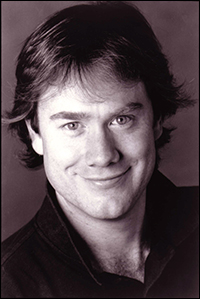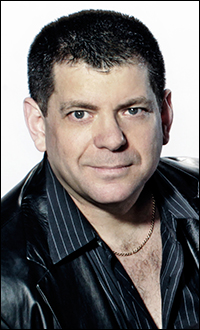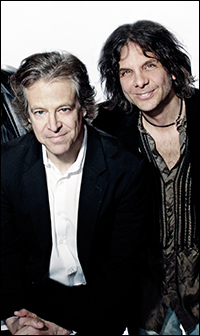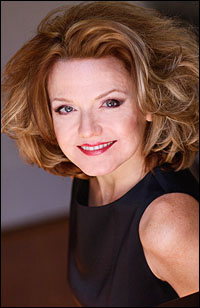
*
Musical theatre careers are punctuated with collaborations that are as intense and robust as any love affair, filled with heat and promise, yet often resulting in a project that hits a dead end: schedules begin to clash, the producer doesn't "get it," money falls through, and so on. The writers move on to other shows and other collaborators, hoping for a hit. The project's pile of scripts, demos and notes gets locked in a trunk, a memento of what might have been. The magic mulls beneath the mothballs, waiting to be found again by historians, fans, or the collaborators themselves. "Remember that show we did…?"
In late 1992, five young composers on the cusp of breaking through — Bob Golden, Paul Scott Goodman, Jonathan Larson, Rusty Magee and Jeremy Roberts — gathered under a banner and created an irreverent look at the Creation Myth (they billed it as "A New Beginning") as the pilot for a weekly cable TV series pitched as "Sacred Cows."
Lost for 20 years, the project has resurfaced. The original "Sacred Cows" demo recording, featuring performances by the composers — including the late Tony Award- and Pulitzer Prize-winning Larson — was released on iTunes on Feb. 28. The story behind the making of the irreverent tale of how Adame, Yves and a three-headed snake oil salesman wound up in Eden is one of starving artists, commercial disappointment and unbridled creativity.
Looking back at the show's origins, its surviving creators spoke about coming together as a team, trying to sell a wacky religion-mocking musical to MTV in the days before "South Park," and their excitement about revisiting an early work. *
It began with Paul Scott Goodman (who would later write Bright Lights Big City and Rooms). A regular at the BMI Musical Theatre Workshop, Goodman began an offshoot project, Multi Media Musicals, to develop musicals for TV and film. Assembling an up-and-coming "dream team," Goodman first turned to a fellow composer and neighbor who'd cast him in a workshop at the Public Theater: Jonathan Larson.
At the time, Larson was routinely doing self-produced runs of his rock monologue tick, tick...BOOM! and recently finished his first full draft of Rent. Hoping to get further work in TV, having provided incidental music for "Sesame Street," but unable to get his vocal songs onto the show, Larson jumped at the chance.
| |
 |
|
| Rusty Magee |
Goodman also knew Rusty Magee (who would subsequently write The Green Heart and Ubu Rock), a composer working the commercial and comedy scenes including an extended run as musical director at the West Bank Cafe Downstairs Theatre Bar, which he ran in partnership with Lewis Black and Rand Foerster, and where he first met Goodman. While production of Magee's new Off-Broadway musicalization of Moliere's Scapin would take him away from the project at times, he served as Goodman's unofficial second in command at Multi Media Musicals.
Also participating was Bob Golden ("Sesame Street," and later TV's "Insomniac with Dave Attell" and Michael Moore's film "Fahrenheit 9/11"), another up-and-comer, already working in television and playing in a band with David Yazbek (who later scored The Full Monty and Dirty Rotten Scoundrels) and Adam Guettel (who was then working on Floyd Collins). A mutual friend at BMI would introduce Golden to Goodman and the workshop. Golden decided to take a chance on the project, seeing it as a learning experience to work with stage composers, an area largely outside his professional interest.
| |
 |
|
| Jeremy Roberts | ||
| Photo by Mary Ellen Mathews |
"There were a lot of egos in the room at the start," says Golden, but as the concept took shape, outlooks became enthusiastic, though Golden also remembers ideas taking precedence over order: "Everybody would go home and write, then bring something in. It was totally the opposite of what I was used to in TV." A week after the first meeting, the five collaborators began bringing in material, and within three weeks, the first recordings were being made, with Roberts producing and engineering in the booth in addition to creating material. Over the five months of writing and recording, songs would be written solo or collaboratively, either on a music/lyrics split or with the entire group pitching in, then reworked and performed by all five members of the team.
*
While the exact format for the series never solidified (would the show be live with an audience or strictly studio-bound?), the first Multi Media Musicals project, now titled "Sacred Cows," was devised and pitched as a weekly anthology with each episode taking a different Biblical or mythological story and giving it a '90s celebrity twist (for example, casting Prince as Icarus) using contemporary music and visuals. "We decided on Bible stories," explains Goodman, "because they were in the public domain and we wouldn't have to pay royalties on them." For the pilot, the team reworked the Garden of Eden story.
"We were years ahead of the game," recalls Roberts. In a television landscape before "Family Guy" and "South Park," observational comedy reigned. Even the wave-maker of the day, "Beavis and Butthead," was focused on mocking suburbia and American life but not challenging its institutions. For American viewers, sarcasm and expression could be edgy, but such direct criticism of traditionally off-limits foundations — like the Bible, say — was still limited to stand-up specials on premium networks, away from advertisers facing the aftermath of 12 years of rule by the Moral Majority. While Jesus Christ Superstar may have been safely ensconced in the cultural landscape, the sheer irreverence of "Sacred Cows" made it a greater gamble to produce.
| |
 |
|
| Paul Scott Goodman and Bob Golden | ||
| Photo by Mary Ellen Mathews |
Unfortunately for God and the Angels, Adame is a little too modern. Despite living in paradise, she frets in rap about how she can't talk to her girlfriends without a phone, let alone find a decent curry. Bored from the start, she wants to leave and find something to do — even bowling, rather than simply hang around and take it easy. To complicate things further, her sex drive is unstoppable: "I want some action and I DEMAND satisfaction."
Finally, Adame's complaints are too much, and while throwing a tantrum, God takes one of her ribs and creates Yves (Goodman), a naked hippie with a guitar affixed to his crotch. Unlike his counterpart, Yves is perfectly happy enjoying the quiet and strum out folk melodies and rhyming variations of "Yippie aye oh" into drippy love poems ("Yippee Aye-Oh Yippie Aye-Ay / Give me an order and I'll obey"). Adame is not amused, and resorts to increasingly drastic measures to woo her asexual mate and strip him of his instrument.
The story isn't complete with out a snake, and in "Sacred Cows," the Serpent manifests as a stogie chomping, three-headed advertising agent who looks to draw the hapless humans to the Tree of Knowledge with a series of catchy jingles. In another modern twist, the tree is a tower of televisions with CDs, VHS tapes and game cartridges hanging off wire branches and boasting a bright red remote.
As the serpent lures them in, the Angels fret: the same mistakes are happening all over again. Adame is down with the idea of the tree, but Yves is hesitant. As the Serpent woos them ("Move a little faster / Let it be your master"), a four-way counterpoint of fear and desire builds. When Adame and Yves succumb, God appears on the screens and condemns them not to banishment, but to house arrest: the pair are doomed to live with the Serpent in the garden, bored for all eternity. As the parking lot is replaced with an idealized set, Adame grows bitterly depressed from the lack of stimulation, Yves celebrates, and the Angels torture the Serpent, asking, "What would you do / stuck in paradise forever?" before departing, content that it will remain "morning forever, in paradise."
| "God (Jonathan Larson) confines Adame, Yves and the Serpents to Eden, for Eternity…" |
|
|
*
"Sacred Cows" could have been indulgent, crude, or an incoherent mishmash of individual styles. It wound up being none of the three. The music builds on early-'90s trends, invoking early alternative-rock bands like Live and Nirvana, plus key female rappers such as Queen Latifah and Salt-N-Pepa. While the lyrics were tongue-in-cheek (the Serpent asks: "How to go about it? / Should we go direct mail? / No post office / Print ad? Billboard? / They can't read"), we can still feel the Angels' tenuous position as they're forced to watch humanity repeating its doomed history and Yves' fear of corruption.
Musically, the score ran on character motifs: ethereal pop for the Angels, early-'90s pop-rap for Adame, country-western for Yves, hard rock for God, and earthy jazz for the Serpent, supplemented by big 1950s-esque advertising jingles. Running in and out of the individual tunes is the Angels' piano motif, a reminder that despite the jokes, disaster is just around the corner. Production-wise, all five collaborators played instruments and sang on the recording, with arrangements handled by Roberts, who deftly pulled everybody's styles together and incorporated both levity and an unearthly air to the recording.
Unfortunately, the satire-happy networks weren't ready for a work so casually undermining a core myth behind American religion. Golden remembers "going with [Goodman] to a meeting with MTV, but nobody knew what to do with it." Despite liking the songs and the ideas, the producers had no idea how to bring the show to life, and passed. The theatrical world responded much the same way: "We did a presentation of the demo for like 30 people at the BMI Workshop, and afterwards, they were silent. I've never been that uncomfortable in my life."
Even so, the project might have fit in well as a boundary-pusher on cable TV. In the early 1990s, MTV was a haven of quirky and offbeat programming, providing an outlet for outsider animation in "Liquid Television," rising alternative comedians such as Denis Leary and Colin Quinn, and would soon be home to cult sketch comedy heroes "The State." Comedy Central, meanwhile, carried "Kids in the Hall" and the derisive, smart-alecky "Mystery Science Theater 3000." Even network comedy was slowly getting its edge back as old stalwart "Saturday Night Live" was entering a renaissance with Phil Hartman, Dana Carvey, Mike Myers, Adam Sandler and Chris Farley leading the bill, while "The Simpsons" topped primetime ratings.
| |
 |
|
| Cover art |
Out of "Sacred Cows," however, came close working relationships between its creators, especially for Golden, who worked frequently with Magee until the latter's untimely passing and collaborated with Larson again in 1994 on the children's video "Away We Go," a musical journey across New York City, which is available on DVD. Golden also performed, along with Magee, in early readings for Rent at New York Theatre Workshop. Much of Rent's creative team would subsequently go on to produce Goodman's Bright Lights Big City at NYTW two years later. In the meantime, the collaborators would all remain close and keep in touch personally and professionally.
*
How do the creators feel about their project 20 years on?
"I'm amazed by how many ideas we all had — there's so much going on. You hear the personalities of the entire team, [everyone's voice] really comes through," says Roberts, the excitement clear in his voice through the phone. "Some of the creative choices we made back in Spring of '93, before the whole animated thing, before irreverence, including a rap..." "It's weird to hear Jonathan Larson singing 'I'm God' and talking about heaven," mentions Goodman. 'We were all so hungry back then..."
"It was a chance for five creators to get together and create," says Roberts. "With most projects, you have a master — such as a producer — but here, we didn't have one. We just got together and did it. It was a true collaboration."
As for Multi Media Musicals, Goodman reminisces: '"Sacred Cows" was meant to be the first project. We started on a few more things, but after Bright Lights Big City went to workshop, the project fizzled out. Jonathan [Larson]'s death also took away a lot of the appeal."
So why release it now? "We decided it's been on the shelf long enough," says Roberts. Goodman is equally excited: "Twenty years later, it's all gonna happen!" Indeed, as the original demo reaches publication, fans will have waited almost a full year for each minute of tape; the demo runs 20 minutes, 25 seconds.
| |
 |
|
| Alison Fraser |
While "Sacred Cows" remained consigned to archive for 20 years, the recording and ideas are still fresh today while still maintaining its early '90s aesthetic. While perhaps not as scathing as the "South Park" creators' treatment of religion on that series or in Broadway's The Book of Mormon, "Sacred Cows" reminds us of how controversial such a project would have been in the pre-Matt Stone and Trey Parker days, a spark from creative people given the freedom to make something for themselves on their own terms, and grants us a musical snapshot of five talented young artists on the edge of ascension.
The track listing for "Sacred Cows: A New Beginning (The Story of Adame and Yves)" follows:
1. Prologue/A New Beginning
2. I'm God (featuring Jonathan Larson)
3. In Paradise (featuring Rusty Magee)
4. Give Me Your Rib (featuring Jonathan Larson)
5. Yipee Ay Oh (featuring Paul Scott Goodman)
6. The Tree Montage (featuring Bob Golden, Paul Scott Goodman, Jonathan Larson, Rusty Magee, Jeremy Roberts)
7. The Apocalypse
8. No More Mister Nice Guy (featuring Jonathan Larson)
9. In Eden
Find more information at the "Sacred Cows" Facebook page.
Permission to include a musical excerpt from "Sacred Cows: A New Beginning" is courtesy of Alison Fraser, Bob Golden, Paul Scott Goodman, the Larson Estate, and Jeremy Roberts.
(Jonathon Collis received his MA in Theatre Studies from the Royal Central School of Speech and Drama and works as a freelance writer and theatre historian in Seattle.)









